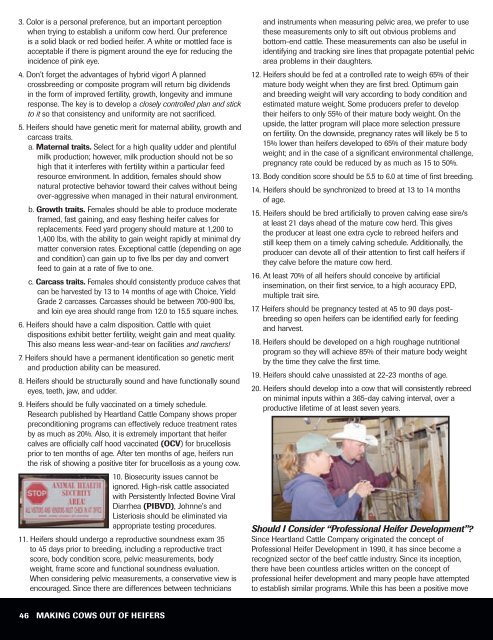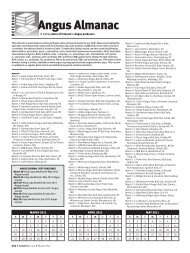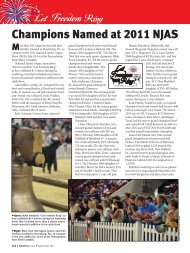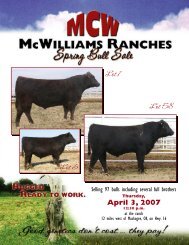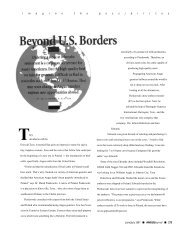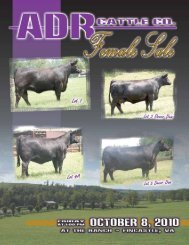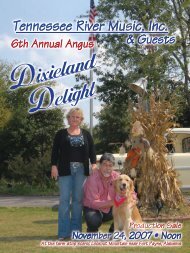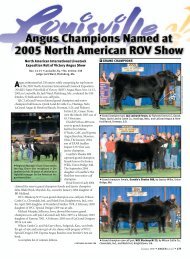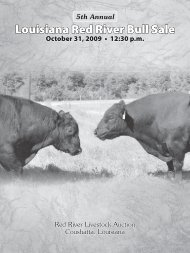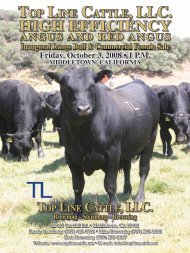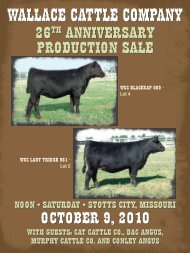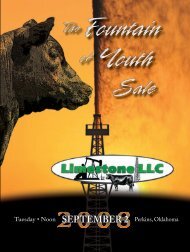Beef Genetic Management Guide - Angus Journal
Beef Genetic Management Guide - Angus Journal
Beef Genetic Management Guide - Angus Journal
Create successful ePaper yourself
Turn your PDF publications into a flip-book with our unique Google optimized e-Paper software.
3. Color is a personal preference, but an important perceptionwhen trying to establish a uniform cow herd. Our preferenceis a solid black or red bodied heifer. A white or mottled face isacceptable if there is pigment around the eye for reducing theincidence of pink eye.4. Don’t forget the advantages of hybrid vigor! A plannedcrossbreeding or composite program will return big dividendsin the form of improved fertility, growth, longevity and immuneresponse. The key is to develop a closely controlled plan and stickto it so that consistency and uniformity are not sacrificed.5. Heifers should have genetic merit for maternal ability, growth andcarcass traits.a. Maternal traits. Select for a high quality udder and plentifulmilk production; however, milk production should not be sohigh that it interferes with fertility within a particular feedresource environment. In addition, females should shownatural protective behavior toward their calves without beingover-aggressive when managed in their natural environment.b. Growth traits. Females should be able to produce moderateframed, fast gaining, and easy fleshing heifer calves forreplacements. Feed yard progeny should mature at 1,200 to1,400 lbs, with the ability to gain weight rapidly at minimal drymatter conversion rates. Exceptional cattle (depending on ageand condition) can gain up to five lbs per day and convertfeed to gain at a rate of five to one.c. Carcass traits. Females should consistently produce calves thatcan be harvested by 13 to 14 months of age with Choice, YieldGrade 2 carcasses. Carcasses should be between 700-900 lbs,and loin eye area should range from 12.0 to 15.5 square inches.6. Heifers should have a calm disposition. Cattle with quietdispositions exhibit better fertility, weight gain and meat quality.This also means less wear-and-tear on facilities and ranchers!7. Heifers should have a permanent identification so genetic meritand production ability can be measured.8. Heifers should be structurally sound and have functionally soundeyes, teeth, jaw, and udder.9. Heifers should be fully vaccinated on a timely schedule.Research published by Heartland Cattle Company shows properpreconditioning programs can effectively reduce treatment ratesby as much as 20%. Also, it is extremely important that heifercalves are officially calf hood vaccinated (OCV) for brucellosisprior to ten months of age. After ten months of age, heifers runthe risk of showing a positive titer for brucellosis as a young cow.10. Biosecurity issues cannot beignored. High-risk cattle associatedwith Persistently Infected Bovine ViralDiarrhea (PIBVD), Johnne’s andListeriosis should be eliminated viaappropriate testing procedures.11. Heifers should undergo a reproductive soundness exam 35to 45 days prior to breeding, including a reproductive tractscore, body condition score, pelvic measurements, bodyweight, frame score and functional soundness evaluation.When considering pelvic measurements, a conservative view isencouraged. Since there are differences between techniciansand instruments when measuring pelvic area, we prefer to usethese measurements only to sift out obvious problems andbottom-end cattle. These measurements can also be useful inidentifying and tracking sire lines that propagate potential pelvicarea problems in their daughters.12. Heifers should be fed at a controlled rate to weigh 65% of theirmature body weight when they are first bred. Optimum gainand breeding weight will vary according to body condition andestimated mature weight. Some producers prefer to developtheir heifers to only 55% of their mature body weight. On theupside, the latter program will place more selection pressureon fertility. On the downside, pregnancy rates will likely be 5 to15% lower than heifers developed to 65% of their mature bodyweight; and in the case of a significant environmental challenge,pregnancy rate could be reduced by as much as 15 to 50%.13. Body condition score should be 5.5 to 6.0 at time of first breeding.14. Heifers should be synchronized to breed at 13 to 14 monthsof age.15. Heifers should be bred artificially to proven calving ease sire/sat least 21 days ahead of the mature cow herd. This givesthe producer at least one extra cycle to rebreed heifers andstill keep them on a timely calving schedule. Additionally, theproducer can devote all of their attention to first calf heifers ifthey calve before the mature cow herd.16. At least 70% of all heifers should conceive by artificialinsemination, on their first service, to a high accuracy EPD,multiple trait sire.17. Heifers should be pregnancy tested at 45 to 90 days postbreedingso open heifers can be identified early for feedingand harvest.18. Heifers should be developed on a high roughage nutritionalprogram so they will achieve 85% of their mature body weightby the time they calve the first time.19. Heifers should calve unassisted at 22-23 months of age.20. Heifers should develop into a cow that will consistently rebreedon minimal inputs within a 365-day calving interval, over aproductive lifetime of at least seven years.Should I Consider “Professional Heifer Development”?Since Heartland Cattle Company originated the concept ofProfessional Heifer Development in 1990, it has since become arecognized sector of the beef cattle industry. Since its inception,there have been countless articles written on the concept ofprofessional heifer development and many people have attemptedto establish similar programs. While this has been a positive move46 Making Cows out of Heifers


